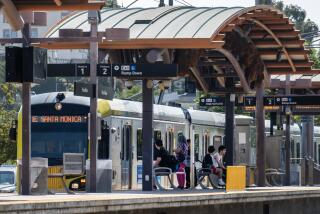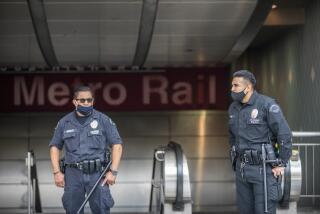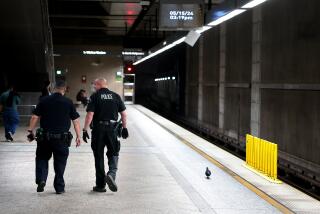Metro pushes again for lockdown on fare evaders
There’s an open secret about getting on the subway in Los Angeles — you don’t really have to pay the fare.
Turnstiles are unlocked, security is lax and commuters often hop over or pass through undetected.
Citing millions of dollars in lost revenue, transportation officials have been wrestling with the issue for years. On Thursday, they made their most forceful push yet to lock the gates to anyone without a ticket at a swath of rail stations.
The effort is the latest bid by the Los Angeles County Metropolitan Transportation Authority to fix a disjointed regional ticketing network that allows some a free ride while creating problems for others who choose to pay.
“There are a lot of people who have been avoiding their fares,” said Zev Yaroslavsky, a county supervisor and Metro board member. “We’re leaving millions and millions of dollars on the table.”
Yaroslavsky wrote Thursday’s motion asking for a plan to implement gate-locking at Metro rail stations within six months. He added that it has been “a long, painful, teeth-pulling exercise” to reach this point.
The subway and light-rail system have operated without locked gates for decades, with Metro officials trusting passengers would do the honorable thing and buy tickets without being forced. Only occasionally would transit officers patrol and issue fines to passengers caught boarding for free.
But ticketing problems arose as the system grew, particularly for riders who transfer to and from other carriers run by different agencies, such as Metrolink.
A batch of turnstiles were introduced in 2009 — although anyone could walk through them without a ticket. Now they are in 40 Metro rail stations , including all of those along the subway, 14 on the light-rail Green Line and five each on the Gold and Blue lines.
The Metro board Thursday passed another measure to ask other transit system operators in the region to change their ticketing systems to sync with Metro’s Transit Access Pass. Eight municipal bus operators are already TAP-enabled and Metrolink officials say they will follow suit this spring.
Yaroslavsky said one reason Metro officials failed to lock the gates sooner is because they were operating under the false assumption that only 3% of riders were evading fares.
“It’s impossible that in a system where there’s, practically speaking, no checking whether people paid their fare or not, that 97% would pay their fare,” Yaroslavsky said.
The Metro staff tested locking gates at 10 stations last fall and winter and reported increased revenue at the 7th Street/Metro Center and North Hollywood stations by 18% to 22%.
Yaroslavsky said Metro probably is missing out on at least $4 million in revenue each year because of fare evasion on the Red Line subway alone.
One effort already underway includes converting paper day passes and single-ride tickets to plastic TAP cards over the next few months, leaving only interagency transfers on paper.
Another idea from the Metro staff is to transition to locked gates incrementally, with only one or two at a time. There also is a plan to install cameras at gated stations later this year.
But they acknowledge there will be difficulties trying to construct locked gates throughout the rail system, particularly because only about half of the stations have gates at all and at some stations there simply isn’t enough space.
Even so, locked turnstiles can be jumped.
More to Read
Sign up for Essential California
The most important California stories and recommendations in your inbox every morning.
You may occasionally receive promotional content from the Los Angeles Times.










